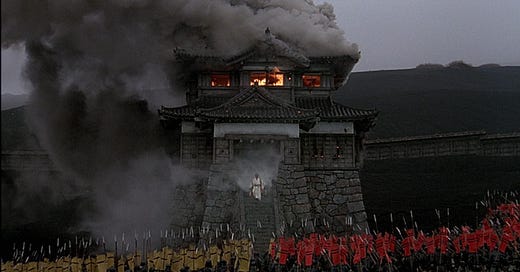While Seven Samurai (1954), an epic of exceptional depth, beauty, and dazzling achievements, is by far my favourite film by Akira Kurosawa, his final film on an epic scale, Ran (1985), is also a staggering achievement. If you have not seen it, this image should be enough to convince you of its power:
Kurosawa had been making one or two films a year for over two decades until 1965 when personal, financial, industrial, and artistic reasons conspired to only allow him to make one film every fifth year, Red Beard (1965), Dodes’ka-den (1970), Dersu Uzala (1975), Kagemusha (1980), Ran, and Dreams (1990). After that he made two final films in short succession, Rhapsody in August (1991) and Madadayo (1993). Of these, Ran stands ahead of the others, whatever their individual strengths may be. It is as if he pulled himself together, and pulled out all stops, to make one final monument and put all his despair and anxieties on the screen. This is a film about hell on earth, with no mercy or escape. Here, hell is not another people, hell is everything and everyone.
Kurosawa’s films have rarely been light and optimistic, even though a dark humour is evident in several of the films from the 1950s and early 1960s starring Toshiro Mifune, including Seven Samurai and Yojimbo (1960). But in the late 1960s they took a distinct turn to an even darker register, with Kagemusha and Ran being the bleakest of the lot.
He began working on Ran already in the 1970s, writing a script and making storyboards, and then letting it rest while making two other films, Dersu Uzala and Kagemusha, and looking for funding. Funds eventually came from France, as well as from Japan, making it yet another international co-production as his films had been from 1975.
Some have suggested that Dersu Uzala was a healing process for Kurosawa, after his suicide attempt and other difficulties. It is also a pantheistic film about the sacredness of the natural world and the ignorance and destruction that human progress bring about.1 But the love and beauty found in that film are nowhere to be found in the two films of the 1980s, with Kagemusha something of a dress rehearsal for Ran, in style, tone, and themes, and Kurosawa has said so himself. And of these two, Ran is the better film, more striking and absorbing. They are of equal length but Ran feels much shorter.
It is based on a Japanese legend concerning the feudal lord Mōri Motonari, but after having begun writing the script Kurosawa realised it had similarities with Shakespeare's King Lear, so he merged the two tales. A warlord retires and his three sons are unable to keep the peace between them afterwards. They tear themselves apart with unrestrained viciousness, while being manipulated by Lady Kaede who has married into the family in order to destroy it. The old warlord goes mad and dies of grief and shock, while castles burn and innocents are slaughtered.
Ran is relentless in its cruelty and darkness, and in its formal audaciousness and intensity; it is a scream of terror. This can undoubtedly be off-putting, and is something of an artistic dead end, or bottomless pit. Where are you going to go after this?
The last three films, after Ran, are not that good, and on a small scale. It is almost incomprehensible that he could make Rhapsody in August, which has the look and feel of a low budget TV-movie, a couple of years after Ran. On the other hand, there was perhaps nothing else to do. It would not be possible to equal, or move beyond, Ran, and he was 75 when he made it.2 Rather than feel disappointed by the last three films, it is fairer to be impressed that he still had this burning need to express himself cinematically, and managed to keep going, however lacklustre the final result might have been.
While watching Ran, and being impressed by it, I do miss Kurosawa of the 1950s. Seven Samurai has such complexity and compassion. There is none of that here, where all is the same from the first to the last shot. Throne of Blood (1957), his first collaboration (it feels like a collaboration across time) with Shakespeare, is more similar to Ran in tone yet it too is a much better film, more rounded and something to watch regularly. I would not like to watch Ran regularly, maybe the two times I have seen it, 30 years ago and now, is enough.
But if you have not seen it, you should.3
I have watched Dersu Uzala at least three times. It is a lovely film, but I have never seen it on a big screen. I hope I will be able to do so eventually.
He also lost his wife Yōko Yaguchi during the production; she died after a short illness only 63 years old.
You should also read Dave Kehr’s review of the film in the Chicago magazine, December 1985, and since republished in Movies That Mattered (The University of Chicago Press 2017).







I watched RAN on screen just last week, and saw it first in 1985 on Opening Night of the New York Film Festival.
I would note that RAN is his most Buddhist film, and not his bleakest. The final shot of the scroll depicting Amida--the Buddha of Infinite Light and Life--is heartening. The continuing embrace of Amida is signified by the fact that, while where the scroll fell allows for no direct light to reach it, the scroll is not portrayed in darkness.
The beauty and hope in RAN resides in how Kurosawa lays out his Buddhist analysis. He does not pull punches about the cruelty human beings can inflict on one another, but also clearly demonstrates the path and decisions that lead to such harms.